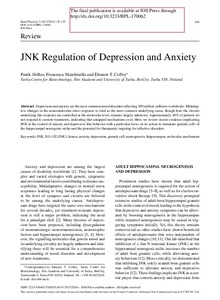| dc.contributor.author | Patrik Hollos | |
| dc.contributor.author | Francesca Marchisella | |
| dc.contributor.author | Eleanor T. Coffey | |
| dc.date.accessioned | 2022-10-28T14:27:00Z | |
| dc.date.available | 2022-10-28T14:27:00Z | |
| dc.identifier.uri | https://www.utupub.fi/handle/10024/171427 | |
| dc.description.abstract | <p>Depression
and anxiety are the most common mood disorders affecting 300 million
sufferers worldwide. Maladaptive changes in the neuroendocrine stress
response is cited as the most common underlying cause, though how the
circuits underlying this response are controlled at the molecular level,
remains largely unknown. Approximately 40% of patients do not respond
to current treatments, indicating that untapped mechanisms exist. Here
we review recent evidence implicating JNK in the control of anxiety and
depressive-like behavior with a particular focus on its action in
immature granule cells of the hippocampal neurogenic niche and the
potential for therapeutic targeting for affective disorders.</p><p>Anxiety and depression are among the largest causes of disability worldwide [<a href="https://content.iospress.com/articles/brain-plasticity/bpl170062#ref001">1</a>].
They have complex and varied etiologies with genetic, epigenetic and
environmental factors contributing to disease susceptibility.
Maladaptative changes in normal stress responses leading to long lasting
physical changes at the level of synapses and circuits are believed to
be among the underlying causes. Antidepressant drugs have targeted the
same core mechanisms for several decades, yet treatment-resistant
depression is still a major problem, indicating the need for a paradigm
shift [<a href="https://content.iospress.com/articles/brain-plasticity/bpl170062#ref002">2</a>].
Many theories of depression have been proposed, including dysregulation
of monoaminergic neurotransmission, neurotrophic factors and
hippocampal neurogenesis [<a href="https://content.iospress.com/articles/brain-plasticity/bpl170062#ref003 ref004">3, 4</a>].
However, the signalling molecules that govern mood and its underlying
circuitry are largely unknown and identifying these will be essential
for a comprehensive understanding of mood disorders and development of
new treatments.</p> | |
| dc.language.iso | en | |
| dc.publisher | IOS Press | |
| dc.title | JNK Regulation of Depression and Anxiety | |
| dc.identifier.urn | URN:NBN:fi-fe2021042719438 | |
| dc.relation.volume | 3 | |
| dc.contributor.organization | fi=biotiedekeskuksen yhteiset|en=Biotiedekeskuksen yhteiset| | |
| dc.contributor.organization-code | 2609200 | |
| dc.converis.publication-id | 32175523 | |
| dc.converis.url | https://research.utu.fi/converis/portal/Publication/32175523 | |
| dc.format.pagerange | 155 | |
| dc.format.pagerange | 145 | |
| dc.identifier.jour-issn | 2213-6304 | |
| dc.okm.affiliatedauthor | Marchisella, Francesca | |
| dc.okm.affiliatedauthor | Coffey, Eleanor | |
| dc.okm.affiliatedauthor | Hollos, Patrik | |
| dc.okm.discipline | 1182 Biochemistry, cell and molecular biology | en_GB |
| dc.okm.discipline | 1182 Biokemia, solu- ja molekyylibiologia | fi_FI |
| dc.okm.internationalcopublication | not an international co-publication | |
| dc.okm.internationality | International publication | |
| dc.okm.type | A2 Review article | |
| dc.publisher.country | Netherlands | en_GB |
| dc.publisher.country | Alankomaat | fi_FI |
| dc.publisher.country-code | NL | |
| dc.relation.doi | 10.3233/BPL-170062 | |
| dc.relation.ispartofjournal | Brain Plasticity | |
| dc.relation.issue | 2 | |
| dc.year.issued | 2018 | |
